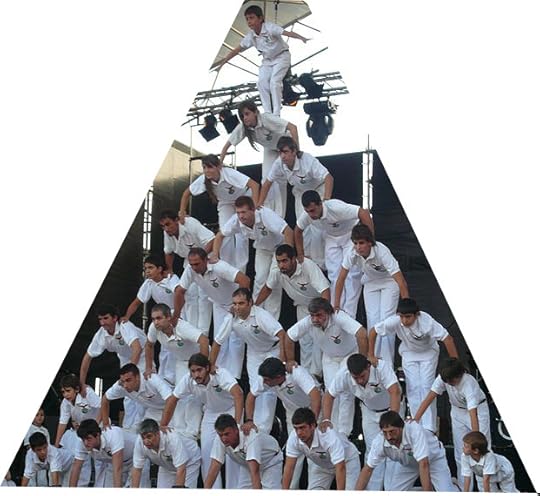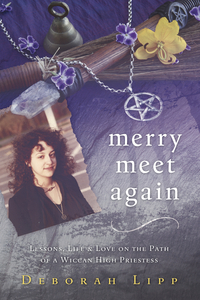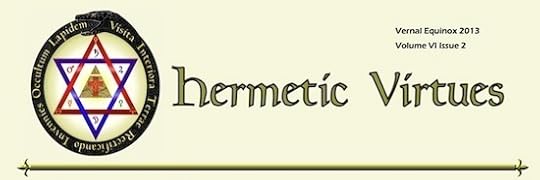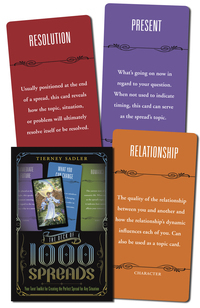Llewellyn Publications's Blog, page 93
April 9, 2013
Leaders or Consensus?
I don’t know who originally stated it (maybe one of my readers knows), but there’s a statement running around the U.S. political blogosphere that “Republicans look for a leader while Democrats look for a consensus.” Whether or not you agree or disagree with this description, it would seem that the organization of occult groups seems to fall into one of two major categories: Those that have a leader whom members follow and those that seek a consensus from all members. Each has benefits and negative aspects. I contend it’s important to understand which format your magickal group, order, coven, etc. follows. By stressing the positive aspects and being aware of the potential negative aspects (and stopping them before they irreparably harm the group) you can assure group success and longevity.
LEADERS
Most groups have leaders. It’s a simple structure that usually follows a pyramidal structure. At the top is the leader. In the middle are his or her administrators. Below that are all the members of the group.
There are many advantages to this “top down” structure. The primary one is that as one of the members you can simply focus on the work. You don’t have to think about structure, organization, the inevitable politics, or anything other than doing the work. If there’s a question, you ask a person in the middle. If you still have an issue you go to the top. What the leader—someone who is theoretically better trained or more knowledgable that you—decides is the final word. After all, due to his or her training, knowledge, ability, experience, and direct links to the inner-plane watchers of your group, he or she has—or should have—the enlightened ability to make the correct decisions and provide the correct answers.
This, unfortunately, is also one of the problems with the top-down structure of leader–administrators–followers. The leader is often seen as having some skills or abilities that others cannot develop for themselves. The leader becomes the unquestionable representation of all that is good about the group, and he or she and the administrators will do whatever is necessary to keep the leader in power.
When the leader is seen as the only link to the inner-plane contacts of your group—the gods, the secret chiefs, the hidden masters, etc.—the group can evolve into a cult of personality. Cults have their own issues, and to determine whether the form of your group is more like a cult than a spiritual group, see the The Advanced Bonewits’ Cult Danger Evaluation Frame available HERE.
Even if your group isn’t a cult, groups with such a pyramidal structure can have other issues, some of which are described in Nick Farrell’s recent blog post HERE. The most obvious problems are based around his point 4 and 5. Point four warns against turning founders into deities. I agree with this. Deities cannot be questioned or disagreed with because, well, they’re freakin’ gods and goddesses! As Noah found out, you don’t say “No” to a god.
However, I think it’s important to add that a problem can exist not only when the founder(s) are deified. It can also be a problem when current leaders become treated as deities or the only link to deities. Naturally, due to their experience, training, and position they deserve respect and their information and advice should hold more weight than a person off the street. But this should be because of its logic and accuracy, not merely because it comes down from on high. Farrell’s first point is that your magickal order is dead (or, I would say, dying) if the group produces no adepts. Unfortunately, in his post he doesn’t define “adept.” I would suggest that one of the signs of an adept is that he or she can go right to the Source of your group’s spirituality—the watchers of your group, the gods, the secret chiefs, the hidden masters, etc.—without needing the leader.
Sometimes, when a group starts off well and does produce adepts, a leader, do to feelings of inferiority and insecurity, starts to claim even higher authority. Only he or she has access to higher powers. Only he or she can provide All New! Previously Secret! Ultra Powerful! wisdom and techniques. In this way the leader tries desperately to keep power. This certainly happened to Golden Dawn groups in the past. It wouldn’t surprise me to see this happen to some of the groups claiming to be Golden Dawn today. It may have already happened.
This leads to Farrell’s point 5. In order to protect his or her power, the leader will make sure that the administrators are “yes men,” never challenging the leader’s authority and always agreeing with the leader. This is bad for any organization.
Perhaps a sort of Fool or Court Jester is needed by occult groups. As quoted in Wikipedia, The Royal Shakespeare Company provides historical context for the role of the fool:
In ancient times, courts employed fools and by the Middle Ages the jester was a familiar figure. In Renaissance times, aristocratic households in Britain employed licensed fools or jesters, who sometimes dressed as other servants were dressed, but generally wore a motley (i.e. parti-coloured) coat, hood with ass’s (i.e. donkey) ears or a red-flannel coxcomb and bells. Regarded as pets or mascots, they served not simply to amuse but to criticise their master or mistress and their guests. Queen Elizabeth (reigned 1558-1603) is said to have rebuked one of her fools for being insufficiently severe with her. Excessive behaviour, however, could lead to a fool being whipped, as Lear threatens to whip his fool.
Although in virtually every occult group I’ve been involved with there has always been one or two people who act like fools, perhaps magickal orders and covens should add as an official post that of Jester, to make sure that people realize the leader is only a leader and neither a god nor the only link to the gods.
Consensus
There are many advantages to rule by consensus. Although I haven’t seen many ceremonial magick organizations run by consensus, there are many covens that are run this way. Everyone has a voice and can be heard. Everyone’s point of view is taken into account. The idea is to avoid the negative problems of the hierarchies created in top-down organizational structures. For some groups, working together to find a consensus works incredibly well and builds a firm bond between members. After all, everyone is equally valued.
But for some groups, trying to find a consensus takes more time than doing rituals. Everyone must be consulted. Everything must be agreed upon. Changes cannot be made without everyone’s approval. All of this takes time, energy, and effort which could be spent more profitably actually doing magickal work or magickal study.
There are several problems with relying on a consensus structure in magickal groups. First, lots of time is used up with organization rather than practice. Second, it necessarily denies any actual links between the spiritual and physical worlds, or at least downplays their value. For example, if an adept with direct spiritual access to those who watch over the Order presents a new ritual to the group, his or her input has no more value than that of someone with no previous experience and who was brought into the group yesterday.
I’ve only seen one attempt to have a consensus structure control a ceremonial magick group. It was a disaster resulting in the group breaking up within two months. What usually happens is that the person without training, learning, and experience does not have the same value to the group (from the perspective of adding to the practices and knowledge of the group) as does the member with such training, learning, and experience. The result is that like it or not, every group develops some type of hierarchy. To deny such a hierarchy is deceptive and misleading.
The idea of avoiding hierarchies through the use of consensus is noble but naive. It seeks to avoid the problems of such top-down hierarchies as described above. However, it also ignores the fact that leadership and hierarchies are natural and have some benefits.
Hierarchies in groups will develop whether you like them or not. By insisting on operating through consensus where everyone has equal say, the problem is that those who just want to follow are placed in positions where they are uncomfortable, and those who are capable and want to lead have their strengths downplayed. Instead of the group trying to make people stronger and capable of working together more effectively, the group ends up bringing people down to a level where people are not doing what they want or what they’re good at. This is not necessarily bad for the individual. Eventually, each person will acknowledge his or her lack of satisfaction with the group and leave it. If the goal of the group is to be transitory then it can be quite successful for that purpose. But for long-lasting spiritual work as a group, such organizations have rarely been successful.
Am I saying that the pyramidal top-down structure is better? As the long description of the potential problems (which barely scratches the surface of such a structure) shows, that’s not the solution, either.
Farrell says in point six from his post,
“It is the duty of every chief to have a clear successor, who is usually an adept who can continue the work of the order. This is particularly important to long established Orders. If the work is focused on the chief, which sometimes happens, then the order closes. However if the group is to continue the successor is obvious and publically recognised to make sure that any transition is smooth. An order is on its way out when it cannot manage this or encourages senior people to fight for the top job. Succession is always based on the person’s magical ability and their contact with the same spirit behind the order. Politics cannot enter into it.
I absolutely agree that “If the work is focused on the chief…[when the leader leaves the group] then the order closes.” I have seen this repeatedly. If the order doesn’t close it certainly becomes worse. Farrell mentions the B.O.T.A. in his post. In my opinion, the founder of the group, Paul Foster Case, chose his successor because she, Anne Davies, was allegedly his mistress, not because she was qualified. She radically altered the information in the group’s teachings, often eliminating material by Case which was of great value.
This also means that a leader of magickal groups should not hand pick or choose a successor. Rather, it should be obvious due to a potential successor’s ability, skill, knowledge, and talent.
This, in my opinion, also reveals a possible solution to the challenge of group structures. Neither the strict top-down structure of leader/followers, nor the loose structure of consensus-only groups is effective in the long term. I would suggest that a combination of both would be far better. Let leaders lead. Let followers follow. Let the hierarchy be open to anyone with appropriate knowledge and skills, not closed to those who disagree with or challenge leadership. At the same time, the goal of the leadership should be to create independent and capable people who have the skills, knowledge and ability to fulfill any role in the group. Improve each member’s individual strengths and let them find where they want to be in the hierarchy and give them the chance to do the work.
And that should be the bottom line. Does whatever format the organization of the group you are part of, or seek to become a part of, best allow you to do the work? Does it allow you to learn more and develop your skills.
Ferrell’s last point, his last sign that your magickal order is dead, is that the members “forget how to do the magic…If for some reason the group starts to forget that it is on its way out.”
To avoid that, just do the work.
The Power of the Aces
It is just now beginning to feel like spring here in Minnesota, even though we still have snow on the ground.
I always associate the Aces with spring, probably because I think of them as seeds full of all the potential of their suit.
Awhile back, I wrote an article about the Aces and created a few spreads to explore their power in our lives. Seems like a good time to revisit it.
Springtime and the Aces
April 4, 2013
Preparing a Deck for Use
Many tarot readers consider their decks as important tools for their magical or spiritual work. As such, they treat them with respect and reverence. Often, they cleanse or charge their decks, dedicating them to specific purposes. This article but Joy Vernon is one of the best I’ve read on the subject.
Reading and Ceremony for Charging a Tarot Deck
http://www.llewellyn.com/journal/article/1329
Do you charge, dedicate, or cleanse your decks, and if so, how?
April 3, 2013
Notes from the Net—Win a Tarot Deck Contest
Hermetic Virtues is one of my favorite journals. The latest issue, Volume VI Number 2, continues their record of excellence. This issue begins with an article by Chic and Tabatha Cicero (You can pre-order the new edition of Israel Regardie’s The Philosopher’s Stone with the Cicero’s incredibly valuable notes and additions now) on “Osiris in the Golden Dawn System.” There is a section, here, that’s fascinating:
…the Throne of Osiris—the Throne of the Spiritual Realm—is situated upon the Dais in the East of the Neophyte Hall, the place of “Light.” Aaron Leitch has pointed out that this was exactly how the Egyptian Gnostics described the Spiritual Realm. In the Gnostic text known as the “Hymn of the Pearl,” the true self, living soul, or spirit of the individual in the hymn “has come from” or “is sent from” the “Kingdom of Light in the East.” The Hierophant’s Throne in the East is described in similar terms: “I am called Power and Mercy and Light and Abundance, and I am the Expounder of the Mysteries … My Throne at the Gate of the East is the Place of the Guardian of the Dawning Sun.”
So it would seem that for the Neophyte Golden Dawn Temple, the evidence shows that Osiris should be in the east.
Next comes a succinct analysis of the Empress card of the Tarot by Harry Wendrich followed by a review of the book, The True and Invisible Rosicrucian Order: The Original Edition by Paul Foster Case. There have been four editions of this book, and the fourth is still in print. Now, the first edition from 1927 has been republished. It’s much smaller than the 4th edition, but for the student of occultism it’s amazingly important because it has within it the color and sound practices that were deleted from later editions. You’d have to spend an astounding 15 years in the group Case founded, the B.O.T.A., to receive these teachings.
Also included is a deep study of the “Triangle of the Art” by Nick Farrell. This is the triangle that is used in magickal evocations as described in my Modern Magick and elsewhere. If you’re interested in evocation, you’ll like this article. This is followed by a controversial article, “The Influence of the Golden Dawn on Wicca” by Peregrin Wildoak. In it he reveals,
Golden Dawn initiates, methods and practices were influential upon the sources of Wicca in terms of developing and promoting new ways of viewing Paganism, Witchcraft, the Pagan deities of the Goddess and the God, spiritual magic and ceremonial forms.
There are several other articles in this 62-page journal.
How to Vote
Other than advising readers to find out the facts on issues and candidates (rather than depending upon propaganda, “spin,” and opinion masquerading as news) and urging people to vote, I try to focus on magick and stay away from politics. However, considering recent events, I think it’s important to make a statement.
There is a type of politics that is known as the politics of groups. Simply put, if you’re a member of a particular group that I also belong to, it’s assumed that I will vote for you. For example, it’s assumed that African-Americans will vote for candidates who are African-Americans, Latinos will vote for Latinos, Roman Catholics will vote for Roman Catholics, people with beards will vote for candidates with beards, etc. Currently, there are a couple of well-known politicians who can trace their ancestry to India, and it’s assumed, therefore, that Americans of Indian descent will vote for them.
The sad thing is, some people do vote this way. Issues and ethics are ignored because “S/he is one of our own.”
With the growing number of open people involved in magick and alternate forms of spirituality, it was inevitable that “one of our own” would become involved in politics. Indeed, a man who self-identified as a Heathen has been described as a “rising star” in New York politics. Because of this he had been the focus of many Pagan blogs and articles.
With respect to all of those writers, I don’t think his religion should have been a focus any more than the religion of any other politician. Rather, as citizens it is our duty to learn the issues and see which politician supports those things that are most in line with what we believe. “He’s a Pagan like us!” shouldn’t be the determining factor of our vote if a politician who is Pagan supports issues that are completely or mostly opposed to our own beliefs. In politics, what matters shouldn’t be a person’s religion. What matters should be what they politically stand for.
Unfortunately, for most of the bloggers and Pagan writers, the joy of having “one of our own” superseded “what does this person stand for?” As a result, this person became someone special to many Pagans.
Now, unfortunately, he is allegedly involved in some illegal and unethical political practices. He was arrested and charged with wire fraud and participating in a bribery conspiracy. If the charges are true, many people who looked at him as “one of us” will be incredibly disappointed.
He is not our community. He is one person. It is important to stay involved in the politics and governance of our country. Look to what people stand for and vote on issues, not because of a person’s skin color, hair color, genetic history or religion.
If you want your voice to be heard don’t depend on someone else merely because you think they might be linked to your faith. Register and vote on the issues.
The Ruby Tablet
The Ruby Tablet number 4 is a new issue of a journal that includes older articles that have been out of print for ages. It begins with an article on “Time and Space” by William Wynn Westcott, one of the founders of the Golden Dawn. Although the information is terribly dated, I find it interesting that he does describe the theory that life on Earth began on other planets and was carried here. This theory has received increasing support over the past 50 years or so (it’s been called “panspermia”), but avoids focusing on the question of how life ultimately began. Another article is on the history and development of magickal wands. There is an amazing interview with R.W. Felkin, another famous Golden Dawn member. This interview covers his dramatic journey through Africa.
A.E. Waite is the source of an article on The Holy Grail which includes a discussion of the idea of Dr. L.A. Waddell that the Grail is a Sumerian “fetish stone-bowl.” It had belong to the first Sumerian King named Dur or Tur, and Waite says that King Arthur “connects etymologically with Tur” (and Thor). An article on the Divine name composed of the Hebrew letters Yud Heh Vahv Heh is included. It was written by Nurho de Manhar, the magickal name of an early member of the Golden Dawn. There is also “An Outline of a Preliminary Ceremony Connected with the Banishing Ritual of the Pentagram.” Written by Ithell Colquhoun (author of a biography of Macgregor Mathers), it was transcribed from her hand-written notes by the editor of the journal, Darcy Kuntz.
Not On Llewellyn’s Website
Llewellyn’s website is one of the most popular destinations for people interested in metaphysical topics. Our free, on-line encyclopedia may be the largest encyclopedia of occult, metaphysical, paranormal, and New Age topics on the web. But there is one book that is published by Llewellyn that you won’t find on our website. This is The Magical Life of Scott Cunningham. That’s because it’s an eBook and not available as a book by itself.
The Magical Life of Scott Cunningham shares never-before published insights into Scott’s life. What were his interests? What motivated him? Why did he write what he did? Why was he so important to modern Wicca and Witchcraft? All of these questions will be answered in this small eBook (it’s just $1.99). Oh…and yes, it was written by me. Scott and I shared a 2-bedroom apartment in San Diego, CA, for six years.
You Still have a Chance to
Win a Free Tarot Deck!
That’s right. The contest is still going. All you have to do is make your best prediction about what will happen this year. The person who makes the most accurate prediction, as determined by our judge (me!), will be able to select any of the many Tarot decks that Llewellyn offers. For full information on this contest, click on this CONTEST LINK.
April 2, 2013
Colors: Enlivening the Rainbow Body
 Readers, please enjoy this guest blog post by Margaret Ann Lembo, author of Chakra Awakening and the new Essential Guide to Crystals, Minerals and Stones.
Readers, please enjoy this guest blog post by Margaret Ann Lembo, author of Chakra Awakening and the new Essential Guide to Crystals, Minerals and Stones.
The array of colors in our energy field and all around us is part of the life giving force that keeps us alive and well. The vibrancy and sparkle of the colors can make the difference between having a hum drum existence to one that is exuberant and full of joy. Here are some guidelines to inspire you to add specific colors for specific reasons in your life. Use the color of clothes (including undergarments and pjs), color of foods, color of décor, and the colors of your gemstone jewelry to add these good vibrations to your life.
Arrange your closet to match the colors of the rainbow to help you make more conscious choices in the way you dress. Chakras—the energy centers of our body, mind, and spirit—can be aligned from head to toe by matching your intention with the color of your outfit and accessories. Use this simple chart to guide you to choose colors and gemstones to match with your intention. Choose your clothes, jewelry, décor and your food with these simple guidelines and watch your life transform.
Color
Chakra
Gemstones
Awakening
Brown and Black
Root
Black tourmaline, black obsidian, aragonite
Grounding, focus, stability, safety, and protection
Red
Root
Garnet, ruby, and red jasper
Vitality, motivation, sensuality, sexuality
Orange
Navel
Carnelian, Amber, Orange Calcite
Fertility, giving birth, manifestation, law of attraction, creativity
Yellow
Solar Plexus
Citrine, Golden Calcite, Golden Topaz
Self –confidence, courage, digestion, clarity, joy, happiness
Pink
Heart
Rose Quartz, Pink Calcite, Rhodonite, Rhodochrosite
Comfort, love, balance, harmony, ease, friendship, romance, overall feel good vibe
Green
Heart
Green aventurine, jade, green tourmaline, green moss agate, green calcite
Compassion, kindness, love, caring, acceptance, tolerance, abundance, companionship, good luck, prosperity
Pastel Blue and Turquoise
Throat
Blue lace agate, chalcedony, angelite, celestite, aquamarine, blue calcite, amazonite, turquoise
Communication, expression, being heard, courage to speak up, truth, Divine inspiration, angelic communication
Indigo and Navy Blue
Throat and Third Eye
Kyanite, Lapis lazuli, sodalite, sapphire
Intuition, inner knowing, truth, Divine alignment, Ascended Masters, inner knowing, spiritual sight, wisdom, grace
Violet and Purple
Third Eye and Crown
Clear quartz, diamonds, selenite, apophyllite, optical calcite, Herkimer diamonds
Inspired living, wisdom, miracles, connection to All That Is, channeling, transformation, Divine Intervention, Higher consciousness
The color red brings energy, motivation, and passion. Just don’t wear too much of it when you are angry! Orange indicates an active and creative time; it also alerts that it is time to get up and move forward in life. When you are drawn to yellow, you are probably ready to let yourself shine your light and increase self-confidence. Blacks and browns are grounding and protective; they make you a bit less obvious. Turquoise, blue, and purple tones illustrate a desire or need for alignment with the Divine. Green and pink are the colors of the heart, love, caring, and compassion.
Both of my books—Essential Guide to Crystals, Minerals and Stones and Chakra Awakening—offer an in-depth understanding of these tools to use to help you have an easier and happier life. Take the time to color your life. Place a rock in your pocket and a good thought in your heart. You will be happy you did!
Our thanks to Margaret Ann for her guest post! For more from Margaret Ann Lembo, read her article “Gemstones: How to Use Colors and Stones to Achieve Your Goals.”
Time to Listen to Your Intuition
Over a decade ago I was feeling frustrated over seeing the way most Westerners thought about Tantra. If you’re like most people, Tantra is “that sex stuff.” Or perhaps you know a bit more about it and thought that it was all about sacred sexuality and extending periods of sexual bliss. In fact, Traditional Tantra consists of some of the oldest, continually practiced Pagan traditions in the world. To say that Tantra is just about sex is like saying Wicca is just about the Great Rite or that the Bugatti Veyron Super Sport, the worlds fastest production car, is just about its gas cap.

Bugatti Veyron 16.4 Super Sport
Photograph by Ian McWilliams
There really is so much more to Wicca, to the Bugatti, and to Tantra. The question in my mind was, “What could I do to make people more aware of the breadth of Traditional Tantra?”
My mind went back to an old story about the Tarot cards. Supposedly, some wise people knew that a great deal of spiritual wisdom would be lost in the coming centuries. To protect that wisdom, they hid the knowledge within a tool—a deck of cards—that could be used for gambling. These people realized that knowledge may come and go but gambling was here to stay. So I thought I’d design a Tarot deck based upon the ancient concept of what I now call “Real Tantra.” This is not to say that other concepts presented as Tantra aren’t real, only that there is a form of Tantra that is much older and more complete.
My Tantric Tarot
So I started out designing the concepts behind a Tarot deck with the symbolism of Traditional Tantra and that was compatible with the concepts presented on the Rider-Waite-Smith deck. I was surprised at how easily and obviously everything fell together. But something was wrong.
One of the basic concepts of Traditional Tantra is known as Svecchachara: (pronounced “s’vek-cha-kar-uh”), which means, “The path of doing one’s own Will.” Some readers will see the similarity between this ancient Sanskrit word and Aleister Crowley’s Thelemic concept, “Do what thou wilt shall be the whole of the Law.” However, there is a difference. The Thelemic concept doesn’t mean “do what you want.” Rather, it means you should discover your True Will and do just that. Your True Will is your direction in life and will be in complete harmony with the universe and the “will” of the Divine. In some ways, it’s actually limiting as it is added in Crowley’s The Book of the Law (I:42), “thou hast no right but to do thy will.” Svecchachara, however, means that you are free to do whatever you want, but you are responsible for whatever you do. There are no limitations, but as per the law of karma, the universe will respond to what you do, positively if you do things that are positive, negatively if you do things that are negative. This is a combination of ultimate freedom combined with ultimate personal responsibility.
What was wrong with my concept of a Tantric Tarot, then, was not the card designs themselves, but rather, the strict limitations placed on the way the cards fall in a Tarot layout or spread. A spread gave context to the meaning of each card, but it also limited the card that fell in a particular position to being focused on one element. What if you needed some other concepts? How would you even know what other concepts should be brought into a reading?

TAROT HOROSCOPE SPREAD
The meaning of each card is modified by the context of the position of the card in the spread.
Trust Your Intuition
There are two major ways to interpret Tarot cards. The first is to memorize meanings of the cards. The second is to look at the image on the cards and use your intuition to determine the meaning. Personally, I believe in blending the two systems. Debunkers and pseudo-skeptics will tell you that a reading is usually so general that it could apply to anyone. However, even a general meaning—for example, you need to trust your intuition more—may appear in one reading and not in another. Why? Why is important for one person to hear a “general meaning” and not another person? The answer, I believe, is that this so-called “general meaning” needs to be heard by one person and not another. It is only superficially general. In practice it is highly specific. [And to those who don't know, Tarot readings can become far more specific than just such a general meaning.]
There have been many times, when doing Tarot readings, that I felt additional information was needed. I would add, according to my intuition, extra cards to the reading, cards that would give extra information. There is no “Tarot Police” saying you can’t do that. So I started thinking, “What if I could add extra cards for extra information whenever I wanted?” Unfortunately, there was still a problem. The positions in a Tarot spread add context to the meaning of each card. How could I add more context to the extra cards?
After thinking about this for some time, I came up with a solution: a second deck of cards. But rather than being like additional Tarot cards, these would be contextual cards. For example, the last card in a reading often has the contextual meaning of “Final Outcome.” The first position often relates to the issue at hand. Another position would relate to hidden influences that the person wouldn’t otherwise know. I could add a bunch of cards that would add context such as the positions in a spread. This secondary deck could be added to create an extra layout that would give context to additional cards in the same way the positions in a spread add context.
And then it struck me. Here was the key to liberating Tarot readings! One entire deck of contextual cards. It could be mixed and put out forming a spread that would be unique for every Tarot reading. This would finally free the Tarot from the constraints and limitations of their use with predetermined layouts. This would be perfect for a truly Tantric Tarot.
The Design
It quickly became clear that the design of the Context Cards would have to be as well thought out as that of a Tarot deck. However, they would also have to be bigger in size. This way you could shuffle the Context Cards, lay them out, then place the actual Tarot on top of them. My plan was that these Context Cards could be used with the Tantric Tarot but also could be used with any Tarot deck.
But there was one problem. Although I’m a whiz as a designer who can take original designs and modify them or adapt them to other uses, I’m not a fine artist at all. I had the concepts, but not the original images. By chance, I discovered an artist who was intrigued by the concept and wanted to work with me on it. His first designs were absolutely breathtaking.
And then it all fell apart. I had some problems with my health and was incommunicado for several months. My hard drive broke down and I lost all of my email and addresses. I had to change internet providers and no longer had my same email. The brilliant artist couldn’t contact me. I had no way to contact him. Life came in the way of what I thought was a great idea. I put it aside and didn’t even think about it for years.
The Miracle of Creation
Several people lay claim to the invention of motion pictures, although Edison usually gets credit. Marconi gets credit for the invention of the radio, but the U.S. courts later determined that credit should actually go to Tesla. The Wright brothers are given credit for having the first powered, heavier-than-air vehicle, but there are others who could claim that they accomplished this before the Wrights.
When good ideas come about, creation is not limited to one person. The miracle of creation is that if people tune into their intuitions, they can tap into the same source as another creator.
That’s why I was absolutely delighted to see that someone else had tapped into the same source as I had once seen. The result is The Deck of 1000 Spreads by Tierney Sadler. If my idea was good, then her’s is utterly brilliant!
Ms. Sadler had created an amazing contextual deck. It allows you to design your own spreads. Each oversized, color-coded card features a spread position (such as “situation” or “outcome”) and a description of this position. You can mix and match the cards to create an entirely original and customized spread for any Tarot reading imaginable. Alternatively, you can begin with a classic spread and use this deck to modify it. This is so far beyond my concept that I am both delighted and totally enthused. In fact, the only disagreement I have with the deck is with the name: it doesn’t limit you to 1000 spreads; crafting an infinite array of spreads with this groundbreaking system is easy.
The color coding divides the deck into five areas including timing, outcomes, influences, people, and themes. You can pick from these areas to design your own reading. You can randomly select from these areas or have the person you’re reading from select from the different colored sections to design a reading that is entirely unique. The possibilities and permutations are literally endless, and it will work with any Tarot deck.
If you are just beginning with the Tarot or are a professional, I strongly urge you to consider adding this deck. It doesn’t replace any Tarot deck you currently use, it simply expands upon and improves what you’re already doing.
Listen to Your Intuition
Even if I had listened to my intuition and pushed ahead with my idea years ago, there is no way it would have been as good as The Deck of 1000 Spreads. I was focused too much on other things. As a result, I’m very glad that Ms. Sadler created this wonderful addition to the Tarot.
I wonder, however, what might have happened if I had followed my intuition at that time. I’ll never know. And as we enter Spring, 2013, I urge you to listen to your intuition. When you come up with an idea, follow it through to the end. Our intuitions are far more powerful than we may think.
Shuffling and Selecting Cards
Once I was in a yarn store with a friend. I was teaching her to knit and we were picking out yarn. The yarn she wanted was in a skein not in a ball, so I told her had to wind it into a ball before she started knitting. She asked, “how do you wind it into a ball?”
I cannot remember when I learned to wind yarn (or string) into a ball. I cannot remember not knowing. It never occurred to me that someone wouldn’t know how.
That happens a lot, when people have known how to do things forever. Shuffling and selecting cards is a lot like that. I tell people to shuffle and draw the cards for the reading. They sometimes look baffled and I realize that they are waiting for instructions, either because they are not card players and just don’t know or because they are afraid they are “doing it wrong.”
I know lots of readers and have seen lots of different ways to shuffling and selecting cards. My best advice is to try as many as you can and pick whatever works best for you. You should pay attention to how the cards feel in your hand; tarot is tactile and sense perception is important. You should also consider your philosophy about the cards. This is particularly true for the card selection. But first, let’s talk about shuffling.
Randomizing the cards
There are several ways to, as Rachel Pollack says, “return the cards to their original state of chaos.”
1. Riffle shuffle
This is when you divide the deck in two and riffle them together. Some people don’t like this method because it bends the cards slightly. Others like it because it is fun, feels good, and is somehow satisfying.
2. Overhand shuffle
This when you hold the cards in one hand longways and pick some up with the other hand and then smoosh them back together. Sometimes people start with a few riffles and end with a few overhand passes.
3. Finger Paint shuffle
This is when you put the deck, face down, on the table and just spread them all over and mix them up, like you are finger painting. I’ve also heard this call Mudpie Shuffle. When you are done, you can gather them up and deal from the top or select the required number of cards for the spread (see selection methods below).
After deciding what method or combination of methods you like, then there is the question of “how many times?” Again, there are many options. Here are a few:
1. Any number you want, but the same number every time.
2. Have the querent pick a number.
3. Determine the subject of the reading, pick a Major Arcana card that matches the theme and use that number. For example, a reading about love-The Lovers, VI-six times.
4. Just keep shuffling until the deck feels done…kind of like baking a cake, you can use a timer and a good baker just “knows” when it is done.
Selecting the cards
This is done after you’ve shuffled the cards, then you need to select the cards needed for the reading. As with all things tarot, there are a number of possibilities.
1. Deal off the top of the deck.
2. Fan the cards out in an arc and have the querent pick the number of cards needed.
3. Fan the cards out in an arc, move your hand slowly over the cards to sense the energy of the cards that want/need to be picked.
I’m sure there are even more options than I’ve mentioned here. But if you are a beginner, these should get you started. The most important thing is that there is no one and only true way to do this. You can and will find your own way of doing things!
March 29, 2013
Wikipedia as a Resource
There are lots of books that can function as powerful resources for magicians, from my own, wide-ranging Modern Magick or The Complete Magicians’ Tables to books going into depth on more specific topics such as Geomancy in Theory & Practice, Hands-On Chaos Magic, or Magickal Self Defense. In my experience, however, many magicians today don’t start research into magickal practices by going into their book collections; some, quite frankly, don’t have many books at all. Instead they depend upon that ubiquitous internet repository of information, Wikipedia.
I love Wikipedia. I think it’s a great tool. But as I have repeatedly pointed out, Wikipedia is a great place to start research but a horrible place to end. They admit themselves:
…Please be advised that nothing found here has necessarily been reviewed by people with the expertise required to provide you with complete, accurate or reliable information…
…Wikipedia cannot guarantee the validity of the information found here. The content of any given article may recently have been changed, vandalized or altered by someone whose opinion does not correspond with the state of knowledge in the relevant fields. [Emphasis in original]
So I would contend that as long as you only begin your researches into a subject having to do with magick or the paranormal on Wikipedia, you are probably off to a good start. But if you depend upon them for in-depth information or accuracy, if you go no further than Wikipedia for information gathering, you could end up with misunderstandings or misrepresentations instead of the truth you seek.
Why Wikipedia Fails
I believe that the concept behind Wikipedia is brilliant. It is the manifestation of that concept where Wikipedia becomes worthless as anything other than a valuable starting point. You may be unaware of it, but anyone can edit anything on their sites. Wikipedia, in the quote above, points this out. Recently one person, with some sort of personal vendetta against certain occult personalities, tried to have many of their entries deleted from Wikipedia. In a similar way, one person can eliminate or make misrepresentations in Wikipedia entries for the valued contributions of important people. Interestingly, Wikipedia will not allow original source material as documentation to claims. They will allow secondary interpretations of that primary material, even if those secondary sources have mistakes and misrepresentations. The fact is, with Wikipedia you never know what you will get.
This was exemplified in a recent blog post by Robert McLuhan. In it he describes a group that calls itself “Guerrilla Skeptics,” a group with the goal of altering Wikipedia entries to put forward their view. Now at first I thought this was more of something that could be traced to the satire website The Onion. To my surprise, there actually is such an organization. Called Guerrilla Skepticism on Wikipedia, they claim that: “ The mission of the Guerrilla Skepticism editing team is to improve skeptical content on Wikipedia. We do this by providing noteworthy citations, and removing unsourced claims from paranormal pages.”
For this group, politics, not facts, becomes the moving force. They will change anything that dares to disagree with them. “Noteworthy citations” can be from their own sources even if the quality of those citations is questionable. Making subtle changes or eliminating anything that counters their opinion is another of their methods.
I have nothing against people who follow what I have repeated called “the religion of scientism” (an ersatz neo-religion based on archaic beliefs). That they may defend their belief system with all the ferocity and fervor of any religious fundamentalists is certainly their right. I do regret that they have usurped the term “skepticism” to mean the denunciation of anything and anyone daring to disagree with their beliefs. I also think that their insistence that they represent scientific thought (they don’t) and methodology (which they don’t follow) should be seen as being as unrelentingly unscientific as those who insist we must all believe that the world is about 6,000 years old and that early humans lived with dinosaurs.
Outgrown Its Original Purpose
No encyclopedia is perfect. There are ones that are more accurate than Wikipedia and some that are wildly less accurate.
However, Wikipedia has outgrown being “just an encyclopedia.” It is considered by many to be the ultimate resource for information on any subject. It is accepted by many people as accurate and correct. Most people never read their disclaimer I shared above. Nor do they look at this other cover-their-butt disclaimer found HERE:
USE WIKIPEDIA AT YOUR OWN RISK
PLEASE BE AWARE THAT ANY INFORMATION YOU MAY FIND IN WIKIPEDIA MAY BE INACCURATE, MISLEADING, DANGEROUS, ADDICTIVE, UNETHICAL OR ILLEGAL.
DO NOT RELY UPON ANY INFORMATION FOUND IN WIKIPEDIA WITHOUT INDEPENDENT VERIFICATION. [Emphasis and all caps in original]
Wikipedia has morphed into what many consider a repository of all wisdom, the akashic records of cyberspace. It has become to the 21st century what the Encyclopedia Britannica was to the 19th and 20th centuries. The difference is that the EB gets articles from “scholars, world leaders, expert writers—even Nobel laureates.” Then they edit the articles and verify the facts before they are published. Britannica is not perfect, nor have they been without criticism. But at least they try for accuracy before publication. Wikipedia doesn’t even make the pretense of doing so.
Wikipedia and the Guerrilla Skeptics Vs. Mrs. Piper
Mrs. Leonora Piper was born in Nashua, NH, in 1857. Her parents claimed she exhibited signs of psychic abilities as a child. In the 1880s about 30 years after the beginnings of the Spiritualist religion, she developed mediumship abilities and could supposedly speak with the dead. She was investigated by numerous individuals.
This post is not an attempt to defend or debunk Mrs. Piper’s alleged mediumship.
Please look again at the sentence centered above. There is no doubt that Mrs. Piper worked as a medium. And yet, without giving any information on her mediumistic exploits, by simply using the word “alleged,” I called into question her entire history. The same is true with my use of “supposedly” in the paragraph above the sentence. You may think I consider everything she did to be bunk. This is a subtle and often overlooked technique of influence, and it’s one that can easily be used on Wikipedia.
I call your attention to this post on the Daily Grail. It points out that the information on Mrs. Piper in Wikipedia includes some debunking comments by the late Martin Gardner. However, the poster had examined Gardner’s in-depth analysis of Mrs. Piper and came up with over a dozen outright errors, including Gardner’s claims that:
Piper’s trances “never occurred spontaneously.” A primary source explicitly says they did.
Her trances “never began when she was alone or asleep.” A primary source says “the access has several times come upon her during sleep.”
“[W]henever a sitter paid for a séance, she had no difficulty going into a trance.” A primary source says “Several times Mrs. Piper was unable to go into trance at all.”
“[C]unning cold reading may account for most of Mrs. Piper’s hits.” Primary sources mention investigators considered cold reading as an explanation, but ruled it out.
She may have used muscle reading by saying Piper “usually” held a client’s hand “throughout a sitting.” Primary sources say that contact was avoided where possible to remove the chance of muscle reading.
Piper might have checked obituaries, birth and marriage records, real estate sales, and reference books. This ignores the fact that the original investigators kept sitters’ identities secret and they were introduced under false names.
Sitters talked freely during seance believing Piper was “asleep,” giving away information. Original investigators noted that they “made it a most careful business not to talk about anything connected with the experiments in Mrs. Piper’s hearing.”
Mrs. Piper’s trance was a fake. Original researchers (including world-renowned physiologists) noted “by an almost universal consensus of opinion her trance is a genuine one.”
So why don’t you see any of this information in Wikipedia? Because it all comes from primary sources—written by people who were actually there—and Wikipedia doesn’t accept primary sources as evidence! This opens the door for individuals with a grudge or self-described guerrilla skeptics to modify entries to support their religious/political agenda.
I say, “more power to them!” Let the guerrilla skeptics pollute all of the entries they desire. The more they control through deleting what they don’t like and entering what they do like—even if their entries are in error—the more people will see Wikipedia for what it is: a bunch of opinions by people with personal agendas.
There is absolutely nothing wrong with that. The only problem is that people see Wikipedia as more than just a collection of such opinions. More and more, however, people are seeing the issues that Wikipedia has. Hopefully, the use of manipulative language, deletion of material that dares to challenge what the (pseudo-) skeptics will allow, and the publication of errors will reduce Wikipedia in the eyes of its users to what it actually is: a great place to start research but a horrible place to end.
March 28, 2013
Writing a memoir: Merry Meet Again by Deborah Lipp
 Last month, a fabulous new book was released. It’s called Merry Meet Again: Lessons, Life & Love on the Path of a Wiccan High Priestess, written by Deborah Lipp. In case you don’t know who Deborah is, in a nutshell she is a 3rd degree Gardnerian Wiccan High Priestess who has written several books for Llewellyn on witchcraft and magic, and one on James Bond (not published by Llewellyn!). She was encouraged to start writing after years of experience running a coven and giving presentations at Pagan and Wiccan festivals by a well-timed tarot reading in 1999, and has been at it ever since.
Last month, a fabulous new book was released. It’s called Merry Meet Again: Lessons, Life & Love on the Path of a Wiccan High Priestess, written by Deborah Lipp. In case you don’t know who Deborah is, in a nutshell she is a 3rd degree Gardnerian Wiccan High Priestess who has written several books for Llewellyn on witchcraft and magic, and one on James Bond (not published by Llewellyn!). She was encouraged to start writing after years of experience running a coven and giving presentations at Pagan and Wiccan festivals by a well-timed tarot reading in 1999, and has been at it ever since.
In her memoir, she has a lot of stories to tell; things like finding Wiccan training before the Internet, using the Descent of the Goddess myth to deal with crippling grief brought on by the loss of her fiance, seeking coven members and running her own group, travelling America, Australia, and Brazil to teach, having eye-opening encounters with goddesses, raising a Pagan child with her former husband, the late Isaac Bonewits, and much more.
It was actually about a year after Isaac passed away in 2010 that Deborah contacted me with the idea of writing her memoir. I didn’t know then that it was part of her way of coping with this loss, but I’m glad that it inspired her to take the first steps on this journey. The book is not about Isaac, although he’s certainly a big part of it as the father of her only child. It’s about her own journey of growth, from the time she was a precocious girl in Hebrew school who fantasized about keeping a kosher home, to praying to Artemis at age 15, to becoming an initiated Witch and priestess. It concludes with her fiftieth birthday and another trip to Brazil, and the birth of a new love affair is attested in the epilogue.
I asked Deborah to share her thoughts on writing this memoir, and I added a few photos from the book. Please enjoy this guest post by Deborah Lipp.

Deborah in 1975
Your life is not a story.
Life is a lived experience, it is in the moment, and the very act of writing down those moments subtly changes them. Shaping a narrative—even the most honest and self-effacing of narratives—alters the experience.
I learned a lot from writing about my life. You might like to apply some of what I’ve learned to a diary you keep, or to journaling as a spiritual or therapeutic exercise.
When I decided to write about my life, I realized that the knowledge that every word is somehow a distortion can be crippling…or it can be freeing. For me it was the latter. Once I understood that I was writing a story, with the same constraints as any story, I was free to edit, shape, delete, and rearrange. I did this all within my commitment to honesty: There are no fabrications in my memoir, Merry Meet Again, no fiction, no little white lies. If I was wrong or foolish, I say so, and I didn’t select only the stories that make me look like an angel (there are so few of those!).
What I did was select the narrative focus of my book: The life of a High Priestess. With that in mind, there were a lot of stories, including some very funny, interesting, and dramatic stories, that had nothing to do with that focus. There is little to nothing in the book about my political involvements, my upbringing, my career, or my romances. Things from other parts of my life were left in only where they contributed to my overall narrative flow. Of course, I had to do that when writing a memoir, unless I wanted a a thousand-page tome.

Isaac Bonewits and Deborah Lipp at Starwood, 1987
There’s a meditative quality to all this, a profound introspection. First, there’s the part where you realize you’re turning your life into a story. That’s a meditation on Being, on how moments are only themselves in their fleeting, ephemeral, non-captured state, and how capturing them changes them. That’s a worthy meditation, and I invite you to try it. Then there’s looking back: You will find, if you research your own life, that you’ve remembered some things incorrectly, and completely forgotten other things that, at the time, seemed unforgettable. There’s an awakening to the richness of things your memory has hidden from you.
Why did I do this? My book was, in part, an outcome of bereavement counseling: When my ex-husband, Isaac Bonewits, was in the last days of his life, and after he died, I found myself looking back on my years with him in a way that cried out for organization, and I organize myself by writing. In part, because my path to Paganism is a path that is at risk of being forgotten: The pre-Internet, deeply closeted, ‘is there anyone out there?’ years are no more, and a journey that was meaningful to many thousands of people risks being treated as fiction. I wanted to document it. I capped off my book with my fiftieth birthday; it felt like a bookend; it felt apropos.

Deborah Lipp today
Finally, I wrote Merry Meet Again because I felt I had something of value to share. As a student of the Craft and then a Priestess, as a Pagan mother, as someone who has traveled throughout the international Pagan community and seen its growth, I felt my perspective had value. I’ve survived some terrible ordeals and have come to know that we can give to others by sharing that they are not alone; our experience has meaning when it can comfort someone else. I hope you can find something in its pages that is meaningful to you.
Full Moon in Libra, March 27, 2013
The Full Moon in Libra occurred yesterday morning at 5:27 am Eastern (9:27 am GMT) at 6 degrees. Full Moons represent the culmination of those things that were begun with the New Moon (in this case the March 11 New Moon in Pisces), which found us evaluating our privacy, intuition, and emotions.
The Libra Full Moon opposes the Sun in Aries; we are reminded to check ourselves in the progress we made towards our goals set during the Pisces New Moon. Are we being balanced (Libra) in our approach? Or, conversely, are we being overly enthusiastic and adventurous (Aries) when we should be more cautious? Keep in mind that Saturn is retrograde until July 7, so this Full Moon period is going to be a reflecting and introspective one.
Llewellyn Publications's Blog
- Llewellyn Publications's profile
- 241 followers








